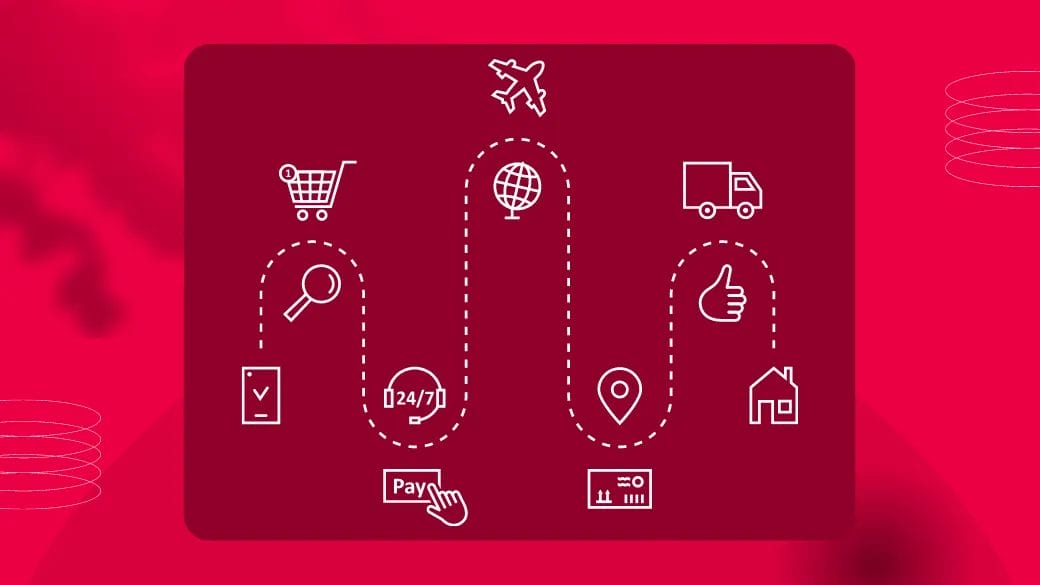Designing the Perfect Post-Purchase Journey
After your customers make a purchase, you need to have a well-designed post-purchase journey in place. Here’s how to do it!

by Chris Latham

You’ve come searching for a way to make a post-purchase journey that wows your customers. That’s an awesome aim and a big part of successful digital marketing.
By improving the post-purchase experience, you can make customers happier and more faithful, while bringing in more money. So, let’s dive in and explore how to craft the ideal post-purchase journey!
What is a post-purchase journey?
The post-purchase journey is what a customer goes through after they finish buying from you. It’s also known as the post-sale experience.
It covers things like getting order confirmations and shipping notifications, customer service requests, loyalty programs, reviews and more.
Making the perfect post-purchase journey is vital. It boosts customer retention and satisfaction. It helps grow profits and lifetime loyalty. Plus, it gives a better user experience. Businesses often don’t realize how important this is.
The goal is to make the journey smooth and easy. That way, customers are more likely to come back. It also shows them how much you value them. A strong post-purchase journey creates chances for:
- Engagement
- Feedback
- Repeat purchases
- Relationships
Ultimately, it leads to high levels of customer satisfaction and retention.
Why is it important?
It’s key to contact customers within two weeks of them purchasing your product or service. Engaging with customers in this post-purchase time is vital. Set up a great onboarding process that builds trust and rises satisfaction. Customers who are engaged are more faithful; they’re also more likely to purchase extra products, speak about their experience and even turn into brand supporters.
Furthermore, a great post-purchase journey decreases churn, enlarges customer lifetime value (CLV) and amplifies revenues from existing customers. It’s a beneficial way of sticking to the assurance you give when people think of buying from you. By sending automated communication tools at each stage of the customer journey fast and conveniently, you can boost relationships while making tangible returns on investment over time.
Setting Up Your Post-Purchase Journey
Yippee ki-yay! You just took the initial step towards setting up your post-purchase experience. Crafting a post-purchase journey is a great strategy to improve customer engagement and loyalty. Doing so offers you an opportunity to establish a more intimate connection with your buyers and nurture relationships.
Want to design an ideal post-purchase journey? Let’s dive in!
Identify customer pain points
After purchase, your customers want a smooth experience with you. So, it is important to recognize customer issues your post-purchase journey should fix. Investigate customer feedback and surveys to spot if customers have problems with delivery, product understanding, or other issues after they buy. Knowing these problems will aid your plan to design an improved post-purchase experience.
Validate the issues by doing more surveys and research to get a better idea of how your customers feel. This helps the business decide which needs are the most pressing and should be addressed within the given design. The goal should be to make sure all the customer issues identified are answered quickly and kindly during their post-purchase journey with you.
Define customer goals
- Honour what customers expect. Automate to define goals and get better results.
- Explore what customers want: fast shipping, extras, or communication.
- Customize each journey and build relationships that last. Consider why they are buying; convenience or something unique?
- Measure success with post-purchase journeys for max ROI.
Set up automated post-purchase emails
Automated emails are the perfect way to make your post-purchase journey more personal and powerful. Set up automated emails for important milestones:
- Delivery Confirmation Email: Confirm when the order is out for delivery with an estimated date and details. Give incentives & discounts.
- Order Follow-Up: Thank customers and ask them to rate/review. Include links to posts and articles to benefit customer experience.
- Post Purchase Offer Emails: Offer discounts on similar products and next orders.
- Loyalty Programs & Rewards Mails: Offer reward points/discounts.
Personalize subject lines with key product info so customers can identify the emails quickly. Use brand identity consistently with logos, contact info, warranties and more. Automating emails saves huge amounts of time and effort!
Crafting the Perfect Post-Purchase Journey
Digital marketers know that customer experience is crucial for keeping customers content and creating loyalty. Crafting an ideal post-purchase journey can help make customers feel appreciated and treasured.
Let’s dive into the main aspects of a successful post-purchase journey. We’ll examine the sorts of experiences you can provide your customers, plus strategies to automate the process.
Create a personalized experience
Crafting a great post-purchase journey begins with personalizing each experience for customers. Product recommendations, emails and delivery instructions can be tailored to each customer’s past purchases and preferences.
As customers progress, their needs will evolve. Be sure to tailor content to meet these changing needs. Consider sending one-to-one emails to customers with unique experiences, such as negative feedback or a problem with their order fulfillment.
To build trust and loyalty, keep your communication consistent across all channels. This includes emails, SMS, and phone. It creates a reliable experience and allows customers to find answers quickly and easily.
Use customer data to personalize content
Using customer data to personalize post-purchase content is key. Collect data on customers to customize communication based on their interests, purchase history, and preferences. Communicate relevant messages to customers post-purchase. For example, if a customer buys for an upcoming event, recommend additional items that would enhance their experience.
Data-driven solutions like predictive analytics can be used to create targeted campaigns. Segment customers according to their shopping behaviour. Identify those with the most potential for repeat purchases and those at risk of waning loyalty.
Craft targeted post-purchase journeys with personalized messages. Consider each cleverly segmented user group’s needs and interests. This will lead to higher rates of conversion, loyalty, and repeat purchases. All thanks to understanding customers and what it takes for them to become loyal brand promoters.
Utilize customer feedback
Gather customer feedback to craft the perfect post-purchase journey! Ask customers how their experience with you was and how it can be improved. Use surveys, questionnaires, direct emails or even telephone. The more feedback, the better!
Be mindful of how customer reactions are collected. Use a friendly and respectful tone. Consider internal resources like marketing automation solutions. Don’t forget to thank customers for their input. They’ll feel valued and heard!
Testing and Optimizing Your Post-Purchase Journey
Comprehending how your customers are engaging with your post-purchase experience is essential. It helps optimize the customer experience and keeps them returning.
We can help design a successful post-purchase journey. Also, we’ll create testing and optimization strategies as well to ensure success.
Analyze customer behaviour
Once you have your post-purchase journey up and running, it’s time to analyze customer behaviour. Test campaigns, measure their performance and look at customer data to see how they interact with each touchpoint. Open rates, click rates and abandon rates can all give insights into customer behaviour.
Evaluate the results of your campaigns and optimize to maximize ROI. Periodically review the results and adjust for changes in customer behaviour or trends. This will keep your post-purchase journey effective, even if external factors like market conditions or technology change.
Test different versions of emails
Optimize your post-purchase journey! Test different versions of emails to increase user satisfaction and purchase frequency. Split testing makes it easy. Create multiple versions of an email or other element in the post-purchase journey. Test the performance for each option against segments in your target audience. Learn what works and what doesn’t. Get insights into customer preferences and behaviours.
Test messaging based on purchase type, customer/prospect status, sector/industry focus, channel preference, and more. Split test A/B email content. Compare two fully developed concepts from subject lines to visuals to content. See which performs better for particular customer segments.
Track the process. Establish KPIs with customer feedback surveys and website analytics. Organize results in dashboards. Make it easy to predict the best outcome for future customer/prospect communications.
Monitor results and adjust accordingly
Keep track of the results of your post-purchase journey. Monitor emails, activities and conversions. Find out if customers are actually buying. Try different copy, subject lines, and offers to see which emails work best. Ask customers for feedback. Look at customer trends over time.
Analyze and optimize:
- Segmentation strategies
- Content
- Communication frequency
- Automation triggers and rules
Use A/B testing to find the best-performing offers. That way, you can have more successful campaigns.
Conclusion
Well done! You have now created a post-purchase journey. This journey should be tailored to your customer’s needs. It should give them a pleasant and memorable experience. Here are some points to keep in mind:
- Congrats! Increase customer loyalty and lifetime value.
- Make sure the journey is tailored.
- Ensure a great and memorable experience.
Summary of post-purchase journey
Gain insight into your customer’s needs by collecting their feedback and designing a post-purchase plan. Align this plan with their expectations to create a great experience.
Engage customers after the sale with automated messages and emails. Personalize these messages with segments and track customer feedback through KPIs. This way, you’ll have the ability to adjust the KPIs and offer an even better customer experience.
Benefits of creating a post-purchase journey
Designing a post-purchase journey for customers has advantages. It builds relationships and adds to business profits. Below are the advantages of an optimal post-purchase journey:
- Customer engagement will raise – Personalized communications will make them feel appreciated, strengthening loyalty and raising return rate.
- Retention will increase – Knowing customer needs through post-purchase journeys will enable delivering relevant content, which increases loyalty and retention.
- Revenues will rocket – Keeping existing customers is simpler than acquiring new ones, especially with expensive marketing spend. Retention costs less than acquisition, meaning more profits.
- Customer satisfaction will grow – Creating an awesome post-purchase journey is like writing a love letter – it shows customers how much they mean. Satisfied consumers will share enthusiasm, leading to referrals and increased sales!
Frequently Asked Questions
What should I consider when designing a post-purchase journey?
It’s important to consider the customer’s experience. It’s important to ensure your post-purchase journey is easy to navigate, offers valuable content and provides the customer with a personalized experience. Additionally, you should consider utilizing automation solutions to help streamline the customer’s journey and make it easier for them to engage with your brand.
How can I create a personalized experience?
You can create a personalized experience by utilizing customer data and segmenting your customers into different groups. This allows you to tailor your post-purchase journey to each customer’s individual needs and interests. Additionally, you can use automation tools to create personalized messages that are triggered by customer behaviour.
What are the benefits of automating the post-purchase journey?
It can help streamline the process and provide a more efficient customer experience. Automation can also help improve customer engagement by sending personalized messages and content at the right time. Additionally, automating the post-purchase journey can help reduce the amount of time and resources needed to manage the process.
